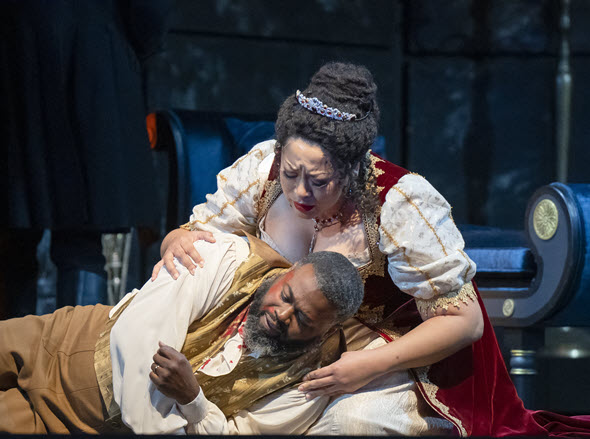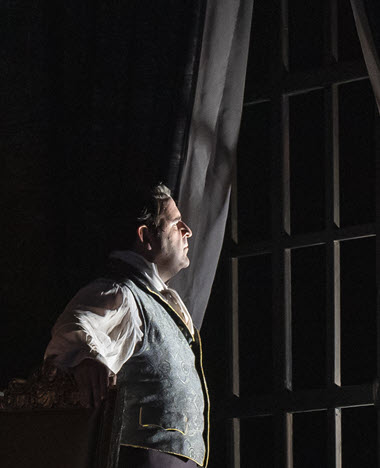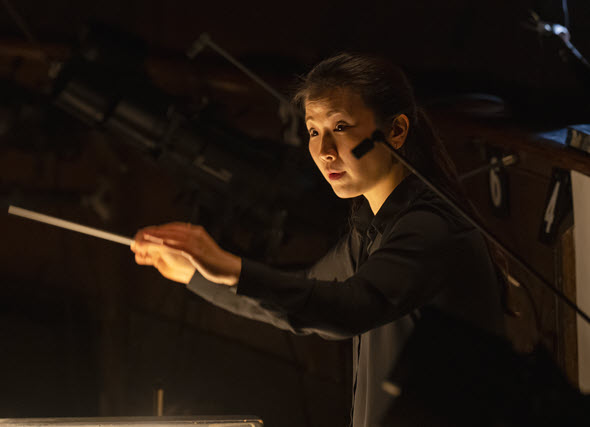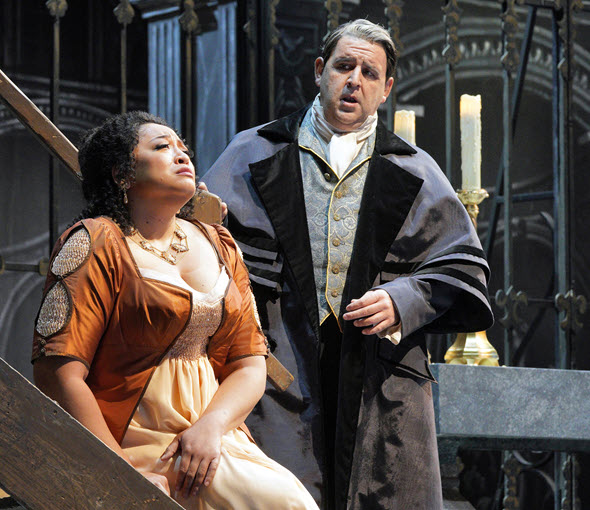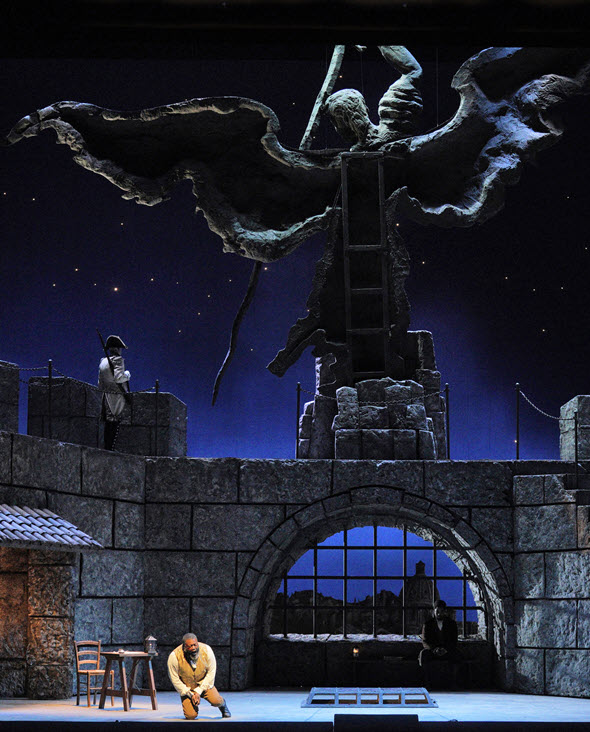Puccini’s ‘Tosca’ at Lyric Opera of Chicago: Love and death in the pitch and tumult of war
Review: “Tosca” by Giacomo Puccini, at Lyric Opera of Chicago through April 10. ★★★★
By Nancy Malitz
What profound, disturbing harmonies permeate the Lyric Opera House in its current production of “Tosca.” And not only at the outset, as Cavaradossi paints a portrait of fair Mary Magdalene while singing “Recondita armonia.” He’s thinking of Mary’s blue-eyed beauty in intriguing contrast to the tempestuous dark-eyed diva Tosca, whom he loves.
The violent circumstance of Puccini’s beloved opera – set in 1800 as Napoleon’s revolutionary republicans are coming into the Italian peninsula from the North, and the Austrian monarchy is holding onto territories further South – is that both the painter and Tosca will die for their loyalty to the same ideals that fired the American Revolution.
Napoleon will abandon those ideals and crown himself Emperor in just a few years. But this is 1800 Rome, combustible and turbulent, controlled by Baron Scarpia, chief of police. Cavaradossi and Tosca are trapped in history’s maw. He will harbor a republican fugitive. She will kill the ruthless Scarpia, who holds Cavaradossi captive. Both will die for their bravery.
Little wonder, then, that someone had the idea of bringing in the Lyric Opera Chorus to sing the Ukrainian national anthem as prelude, to a vociferously supportive crowd on opening night March 12. In the tumultuous context of this historic moment, the imponderables that Puccini and his librettists explore so deftly seem starkly relevant.
There is much to admire in Lyric’s grand mounting of this vintage Jean-Pierre Ponnelle production, starring American soprano Michelle Bradley in her Lyric debut as the charismatic diva, Argentine baritone Fabián Veloz as her conniving nemesis Scarpia and American tenor Russell Thomas as Cavaradossi. The production is a lavish classic that first appeared on the San Francisco Opera stage in 1972. It has since played around the world and is now under the stewardship of the San Diego Opera. Performances at the Lyric continue through April 10.
The Ponnelle production (helmed insightfully here by director Louisa Muller) still electrifies with its passion and subterfuge, its reversals and political terror. The music itself could not be more grandly persuasive under guest conductor Eun Sun Kim, who is now music director of the San Francisco Opera. She wowed audiences last summer with the Grant Park Orchestra at Millennium Park in performances of another very familiar work, Dvorak’s “New World” Symphony, which under Kim seemed fresh and new. At Lyric as well, she made a debut of rare eloquence, meticulously supportive of the singers, who must have loved working with her. The Lyric Opera Orchestra ranged from sounding serene and sumptuous to molten and terrifyingly charged.
The set itself is classic Ponnelle in design, architecturally framed to give the impression of massive spaces, ornate and elegant. Act 1, where Cavaradossi is at work on his Mary Magdalene painting, takes place in a fictional devotional chapel behind the altar of the Sant’Andrea della Valle Church. The church itself is a real structure in Rome, built in the first half of the 1600s, lavishly domed and gilded, with sumptuous frescoes. Acts 2 and 3 are set in other famous places: The massive Farnese Palace is where Scarpia first tricks Tosca into revealing the secret hiding place of the fugitive whom Cavaradossi harbors. That secret successfully pried, Scarpia then attempts to seduce Tosca with a lie that purports to save Cavaradossi’s life. The roof of the cylindrical Castel Sant-Angelo, a military fortress and mausoleum that dates from the second century, is where Cavaradossi and Tosca meet their ends. Anyone in Rome, which is opera-loving to its core, can point these places out.
There are many ways to play Scarpia, from unrelenting ferocity to something more cleverly refined. Veloz was the latter, a villain who rarely barked, yet with his smooth baritone affected a bad guy so unctuous in his evil that you cheered to see him go. Veloz’ “Va, Tosca,” sung in church as a dark Te Deum counterpoint, ends with the deliciously insidious “Tosca, you make me forget God,” which by then is Veloz’ open secret.
The vocally impressive soprano Bradley gave us a youthful, hot-blooded Tosca in the first act, as full of life as any modern woman. This diva’s fall in the second act, as she is shattered by Scarpia’s successive cruelties, was achingly well done. Her “Vissi d’arte,” sung with the conviction that she must submit to Scarpia, swells with memory and heartbreak. It leads directly to the impulsive murder that Tosca seizes upon, in the conviction that it is her only chance of escape with Cavaradossi. As for the chances of death by knife succeeding in the diva’s hands, the threat has frankly never seemed very likely. But the method has defied plausibility over the decades, and Bradley got the job done.
Puccini’s opera races to its end from there. Russell Thomas is of large stature, with a voice that tends heroic rather than pensive, but his third act “E lucevan le stelle,” sung on Cavaradossi’s last night alive, offered a splendid scene of resignation and fragile tenderness. The bravura pairing of Thomas and Bradley is one that the opera world, and hopefully Chicago, would do well to see again.
In a generally strong supporting cast, special mention is due to bass Rivers Hawkins, a first-year Ryan Center member who played panicked and distraught Angelotti, supporter of the republican cause and friend of Cavaradossi, now in desperate need of some sustenance and a place to hide. And the bass-baritone and Ryan Center alumnus Alan Higgs played the Sacristan as a bumbling helpmate to the painter, one of the opera’s traditionally endearing characters in the precious few light minutes before the story’s grim turn takes hold.
Related Link:
- Performance location, dates and times: Details at TheatreInChicago.com

